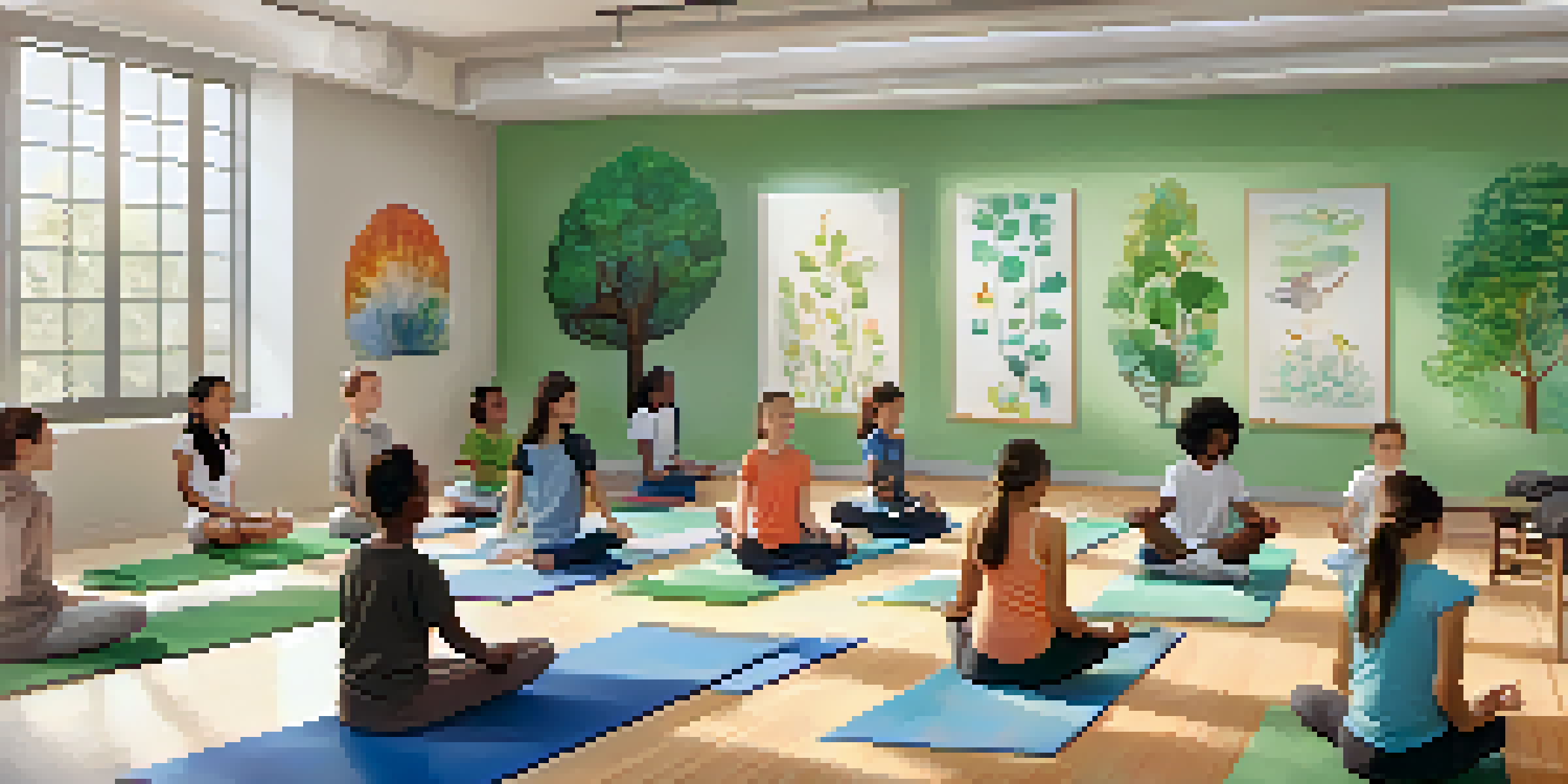Mindfulness in Physical Education: Enhancing Focus and Performance

Understanding Mindfulness and Its Benefits in PE
Mindfulness is the practice of being present and fully engaged in the moment. In the context of physical education, it involves focusing on the body, breath, and movements during activities. This heightened awareness can lead to improved concentration and reduced anxiety, which is crucial for athletes and students alike.
Mindfulness isn't difficult. What's difficult is to remember to be mindful.
For instance, a student practicing mindfulness may find it easier to tune out distractions, enabling better performance during a game or exercise. This not only enhances their physical capabilities but also promotes a positive mindset. By fostering a sense of calm and clarity, mindfulness can significantly impact how students approach physical activities.
Furthermore, incorporating mindfulness into PE can help students develop skills that extend beyond the gym. As they learn to focus their thoughts and emotions, they can apply these techniques in academic settings and daily life, creating a well-rounded individual.
The Role of Breath Control in Enhancing Performance
Breath control is a fundamental aspect of mindfulness that can greatly influence physical performance. When students learn to regulate their breathing, they can enhance their stamina, focus, and recovery during physical activities. For example, athletes often use deep breathing techniques to manage stress before competitions.

By teaching students to use their breath as a tool, physical education instructors can help them improve their overall performance. A simple technique, such as inhaling deeply through the nose and exhaling slowly through the mouth, can lead to increased oxygen flow and reduced heart rates. This not only helps in physical exertion but also calms the mind.
Mindfulness Boosts Performance
Practicing mindfulness enhances students' focus and reduces anxiety, leading to improved performance in physical activities.
Incorporating breath control exercises into PE classes can foster a culture of mindfulness. Students learn to recognize when they are becoming overwhelmed and can use their breath to regain composure, which can lead to better decision-making and execution during sports.
Mindfulness Techniques to Implement in PE Classes
There are several mindfulness techniques that can be seamlessly integrated into physical education classes. One effective method is starting each class with a short meditation session, allowing students to center themselves before engaging in physical activities. This practice can help them transition into a focused state, ready to learn and participate.
The mind is everything. What you think you become.
Another technique is mindful movement, where students are encouraged to pay attention to their bodies as they engage in sports or exercises. Whether it's stretching, running, or playing a game, focusing on how their bodies feel can enhance their experience and performance. This practice encourages a deeper connection to their physical capabilities.
Additionally, implementing reflective practices, such as journaling or group discussions about mindfulness experiences, can reinforce the lessons learned in class. By sharing their thoughts and feelings, students can build a supportive community that values both physical and mental well-being.
Creating a Mindful Environment in the Gym
A mindful environment in a physical education setting is essential for fostering focus and performance. This can be achieved by minimizing distractions, such as loud noises or clutter, and encouraging a supportive atmosphere among students. A calm and organized space can significantly enhance the mindfulness experience.
Instructors can also set clear expectations regarding behavior and participation, which can help students feel more secure and focused. When students know what to expect, they can direct their attention to the activities at hand rather than worrying about other factors.
Breath Control for Better Focus
Regulating breath helps students manage stress and increases their stamina, positively impacting their physical exertion.
Moreover, using calming visuals, such as nature-themed decorations or soft colors, can contribute to a peaceful ambiance. Creating a mindful environment allows students to feel comfortable and engaged, which is crucial for promoting mindfulness in physical education.
The Connection Between Mindfulness and Team Sports
Mindfulness plays a significant role in team sports by fostering cooperation and communication among players. When athletes practice mindfulness, they become more aware of their teammates' movements and intentions, leading to better teamwork. This heightened awareness can improve overall performance and create a more cohesive unit on the field.
For instance, during a basketball game, a player who is mindful of their breath and surroundings can anticipate their teammate's next move. This anticipatory skill not only enhances gameplay but also builds trust among team members. The more connected players feel, the better they can work together towards a common goal.
Furthermore, mindfulness can help athletes manage competition-related stress, which is often heightened in team settings. By focusing on the present moment and supporting each other, teams can create a positive atmosphere that encourages growth and success.
Measuring the Impact of Mindfulness in PE
Evaluating the impact of mindfulness practices in physical education can be a valuable way to understand their effectiveness. Instructors can track students' focus levels, performance metrics, and overall engagement before and after implementing mindfulness techniques. These assessments can provide insight into how mindfulness influences both physical and mental aspects of performance.
For example, teachers may observe improved participation rates, lower anxiety levels, or enhanced skills in students who regularly practice mindfulness. Surveys and feedback forms can also help gauge students' perceptions of mindfulness's impact on their PE experience.
Creating a Supportive Environment
Establishing a mindful environment in PE promotes engagement and fosters a sense of community among students.
Ultimately, measuring the effects of mindfulness allows educators to refine their approaches and tailor practices to better suit their students' needs. By consistently evaluating and adapting their methods, instructors can ensure that mindfulness remains a valuable component of physical education.
Future Directions for Mindfulness in Physical Education
As the understanding of mindfulness continues to evolve, there's a growing interest in its application within physical education. Future directions may include the development of specialized training programs for PE teachers, equipping them with the skills to effectively implement mindfulness in their curricula. This could lead to a more standardized approach across schools and districts.
Additionally, integrating technology, such as mindfulness apps or virtual reality experiences, could enhance the accessibility of mindfulness practices for students. These tools can provide guided exercises and reminders, making it easier for students to incorporate mindfulness into their daily routines.

Ultimately, the future of mindfulness in physical education looks promising. By embracing innovative methods and ongoing research, educators can continue to enhance students' focus, performance, and overall well-being through mindfulness.